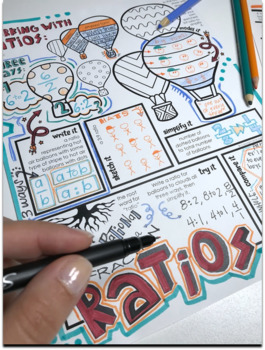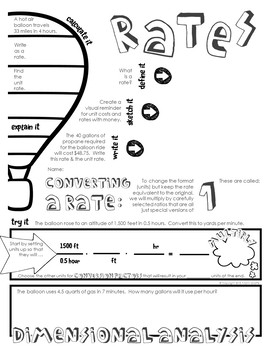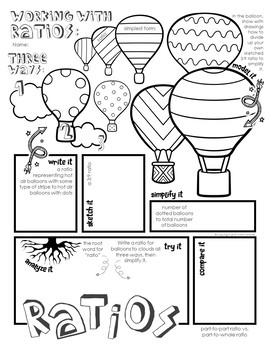Ratios and Rates Doodle Notes
Math Giraffe
25k Followers
Resource Type
Standards
CCSS6.RP.A.1
CCSS6.RP.A.2
CCSS6.RP.A.3
CCSS6.RP.A.3b
Formats Included
- PDF
Pages
2 plus answer keys & info
Math Giraffe
25k Followers
What educators are saying
What a fantastic way to help students take notes. They seem to focus more because they have to fill in the missing parts. Your notes are very detailed and don't skimp on the skill. I like the fact that you do them in step-by-step as well.
Unit rates are a little difficult and this resource helped my students visually see and get familiar with he steps.
Description
Ratios & Rates: 2 page visual interactive "doodle notes" set -
When students color or doodle in math class, it activates both hemispheres of the brain at the same time. There are proven benefits of this cross-lateral brain activity:
- new learning
- relaxation (less math anxiety)
- visual connections
- better memory & retention of the content!
Students fill in the sheets, answer the questions, and color, doodle or embellish. Then, they can use it as a study guide later on. Graphic doodle and sketch notes take full advantage of Dual Coding Theory (the way brains process visual and linguistic information) to maximize retention.
Content includes:
- 3 ways to write a ratio
- simplifying a ratio
- writing and modeling ratios
- calculating and working with rates
- finding a unit rate
- unit factors and converting rates
- dimensional analysis
- interactive tasks
- graphic reminders to build retention
- examples
Check out the preview for more detail about this item and the research behind it.
Visual note taking strategies like sketch notes or doodle notes are based on dual coding theory. When we can blend the text input with graphic/visual input, the student brain processes the information differently and can more easily convert the new learning into long-term memory.
This strategy also integrates the left and right hemispheres of the brain to increase focus, learning, and retention!
Loving the doodle notes? Grab the full book of Pre-Algebra doodle notes here:
Pre Algebra Doodle Note Book
When students color or doodle in math class, it activates both hemispheres of the brain at the same time. There are proven benefits of this cross-lateral brain activity:
- new learning
- relaxation (less math anxiety)
- visual connections
- better memory & retention of the content!
Students fill in the sheets, answer the questions, and color, doodle or embellish. Then, they can use it as a study guide later on. Graphic doodle and sketch notes take full advantage of Dual Coding Theory (the way brains process visual and linguistic information) to maximize retention.
Content includes:
- 3 ways to write a ratio
- simplifying a ratio
- writing and modeling ratios
- calculating and working with rates
- finding a unit rate
- unit factors and converting rates
- dimensional analysis
- interactive tasks
- graphic reminders to build retention
- examples
Check out the preview for more detail about this item and the research behind it.
Visual note taking strategies like sketch notes or doodle notes are based on dual coding theory. When we can blend the text input with graphic/visual input, the student brain processes the information differently and can more easily convert the new learning into long-term memory.
This strategy also integrates the left and right hemispheres of the brain to increase focus, learning, and retention!
Loving the doodle notes? Grab the full book of Pre-Algebra doodle notes here:
Pre Algebra Doodle Note Book
Total Pages
2 plus answer keys & info
Answer Key
Included
Teaching Duration
45 minutes
Report this resource to TPT
Reported resources will be reviewed by our team. Report this resource to let us know if this resource violates TPT’s content guidelines.
Standards
to see state-specific standards (only available in the US).
CCSS6.RP.A.1
Understand the concept of a ratio and use ratio language to describe a ratio relationship between two quantities. For example, “The ratio of wings to beaks in the bird house at the zoo was 2:1, because for every 2 wings there was 1 beak.” “For every vote candidate A received, candidate C received nearly three votes.”
CCSS6.RP.A.2
Understand the concept of a unit rate 𝘢/𝘣 associated with a ratio 𝘢:𝘣 with 𝘣 ≠ 0, and use rate language in the context of a ratio relationship. For example, “This recipe has a ratio of 3 cups of flour to 4 cups of sugar, so there is 3/4 cup of flour for each cup of sugar.” “We paid $75 for 15 hamburgers, which is a rate of $5 per hamburger.”
CCSS6.RP.A.3
Use ratio and rate reasoning to solve real-world and mathematical problems, e.g., by reasoning about tables of equivalent ratios, tape diagrams, double number line diagrams, or equations.
CCSS6.RP.A.3b
Solve unit rate problems including those involving unit pricing and constant speed. For example, if it took 7 hours to mow 4 lawns, then at that rate, how many lawns could be mowed in 35 hours? At what rate were lawns being mowed?





